WordPress Quiz Plugin + After Registration Extended Profile Fields - Use Case - How to Ask a User to Add Additional Information After He Passed a Quiz
Use Case – How to Ask a User to Add Additional Information After He Passed a Quiz
Note: This guide covers features from:
- WordPress Quiz Plugin - This document uses version 1.2.0
- After Registration Extended Profile Fields - This document uses version 1.0.9
Video Use-Case
Introduction
The WordPress Quiz Plugin allows you to add quiz knowledge tests with multimedia content and multiple answers anywhere on your posts and pages. You can also monitor the results of your audience.
After Registration Extended Profile Fields is a WordPress plugin that allows you request information from your users after they have registered, enriching their profiles. This powerful plugin boasts a visual Profile Form builder and allows the admin to automatically update the role of users who complete the questionnaire.
Use Case Front-End
The user role before passing a quiz and completing the questionnaire is Subscriber.

The user passes the quiz:

When the quiz is successfully passed, the user sees the questionnaire:
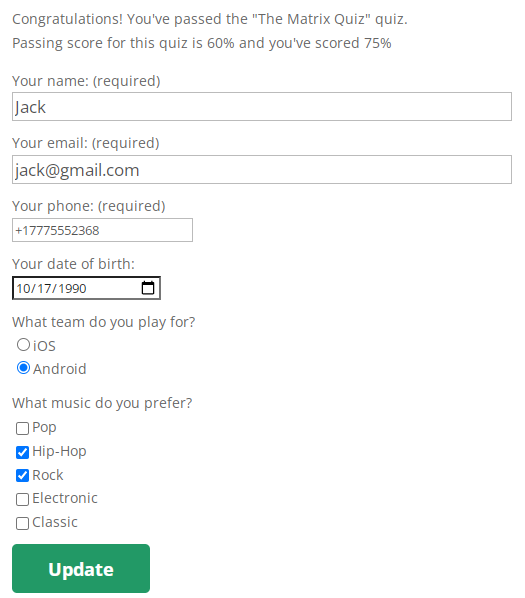
When the user fills all needed fields and clicks Update, there appears a message about success:
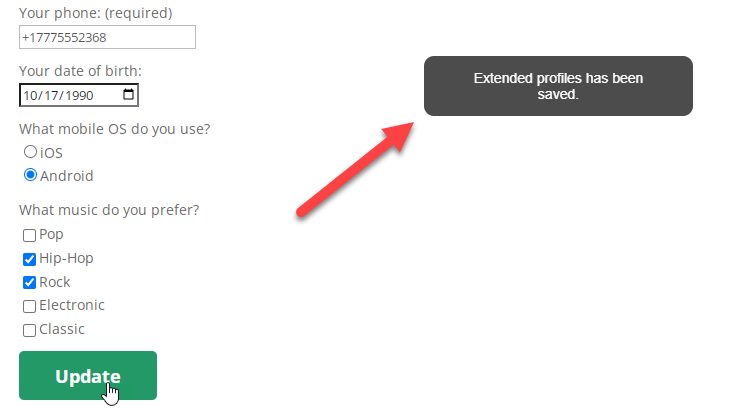
And his user role is changed:

Use Case Assumptions
In this example use case guide we will consider how to integrate these two plugins together and ask users to add additional information after they passed a quiz. It allows upgrading their user role and extending their capabilities on your site.
We consider that you have already bought both plugins, but not installed them yet.
It follows:
- Installing the plugin
- Quick recap
- Configuring the after registration settings
- Configuring extended profile fields
- Configuring quiz settings
- End result
Installing the Plugin
The process is the same for all CM plugins and add-ons.

- Download the plugin from your customer dashboard.
- Log in to WordPress and navigate to the WordPress Admin → Plugins settings.
- Click on Add New.
- Activate it and add the license.
Learn more: Getting Started - Plugin Overview
Quick Recap
In this use case guide we will focus mostly on the crucial functions of integration between two plugins.
To learn more about configuring the WordPress Quiz Plugin and creating quizzes, check this use case:
To learn more about configuring the After Registration Extended Profile Fields plugin, check this use case:
Configuring the After Registration Settings
Let's start with configuring the settings for the After Registration Extended Profile Fields plugin. To do this, navigate to Admin Dashboard → After Registration → Settings.

We need 3 options under the General tab:
- Display notice automatically - Disable this option, if you want to give the ability to upgrade accounts only to users that pass quizzes.
- Roles - Choose the user role that will be given an opportunity to upgrade their account after passing a quiz.
- Assign new role after the form is filled? - Choose the role that users will have after completing the questionnaire.
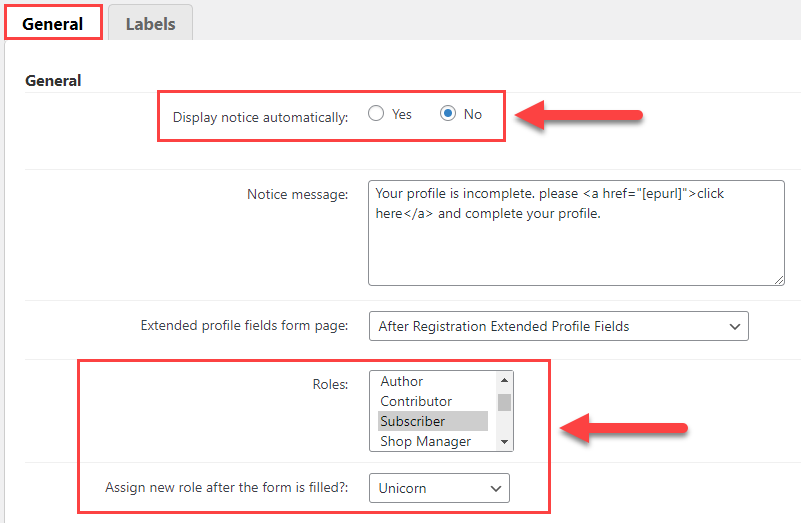
After changing the settings, click the button Save at the bottom of the page.

TIP: User Roles
As there's ability to upgrade the user role after completing the questionnaire, it might be useful for to have ability to create new user roles and change user capabilities. It can be done with a help of third-party plugins. One of them is User Role Editor. Learn more about how the User Role Editor plugin works: User Role Editor - Documentation.
Configuring Extended Profile Fields
To upgrade the user role, users will have to complete the questionnaire. You can edit what fields it will have, depending on what information you need from your users. To configure it, navigate to Admin Dashboard → After Registration → After Registration.
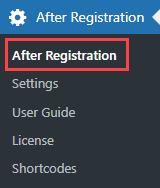
There you can see the Form Builder.
Fields are extremely versatile: they can be used for adding a phone number, a short blurb, a description of the service they provide, asking if a subscriber is over 18 or not, and many more.
You can add any input field from the list on the right by dragging and dropping them to the zone on the left. For convenience, the fields can be minimized by clicking on the pencil icon that appears at the top right while hovering over an input field's settings area.
The custom input fields can be reordered by clicking and holding it and then dragging it up or down as desired.

Types of Input Fields
There is a selection of different input fields available to choose from to control the type of data being entered by users.
- Text Input - Creates a small input area for plain text.
- Text Area - Creates a large input area for plain text. Better for blocks and paragraphs of text.
- Number - Creates an input area that will allow numbers only.
- Select - Creates a drop-down menu to choose from.
- Radio Group - Creates a list to choose from by clicking on radio buttons. Limited to one choice.
- Checkbox Group - Creates a list to choose from by clicking checkboxes. Allows multiple choices.
- Date Field - Creates a date selection field with a drop-down calendar date picker, an up-down incremental selector or manual input options.
Each of these input types has their own configurations specific to them.
Settings Common to All Input Fields
There are also settings that are common to every field and affect the general behavior of the form.
- Change Label - Edit the front-end label for the input field.
- User Meta Key - The key to the user meta record in the database. It's recommended to change this to something more easily remembered using alphanumeric characters and underscores.
- Required - Check this box to make the input field required for the user to complete the registration form.
- Restrict to Roles - Show the field only to the selected user roles.
- Tooltip Text - Tooltip that will appear on hovering.
- CSS Class - Filled automatically, but can be customized.
- Some fields might have the setting Placeholder - so, you can write some text to give users a hint what type of the answer is supposed to be
Let's create the following form:
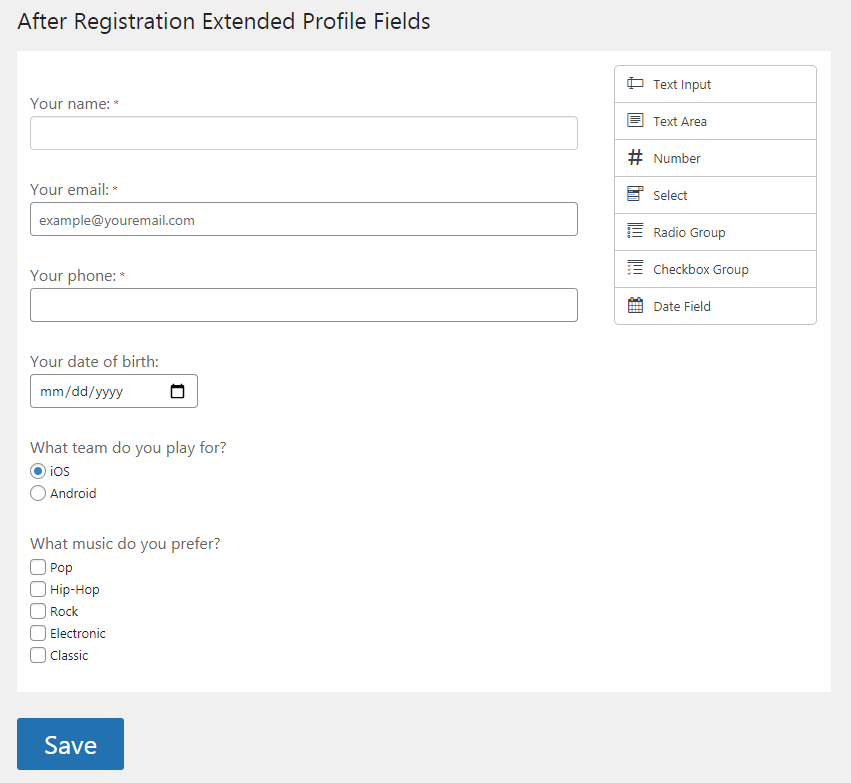
Don't forget to click the Save button to save your form.
Configuring Quiz Settings
Now we need to enable the integration between two plugins. Navigate to Admin Dashboard → CM Quiz Manager Pro → Settings.

Here we need two options:
- Default correct answers percent to pass a quiz (0 - 100) - Indicates what percentage of correct answers should be given to pass the quiz. This setting can be changed per quiz. The questionnaire with extended profiles fields will be displayed only for users that passed the quiz.
- Allow to get additional information from user if passed - This option enables integration with the After Registration Extended Profile Fields plugin. Have a note that the form with questionnaire will be displayed to user after passing any quiz on your site, you can't choose any specific quiz for that.
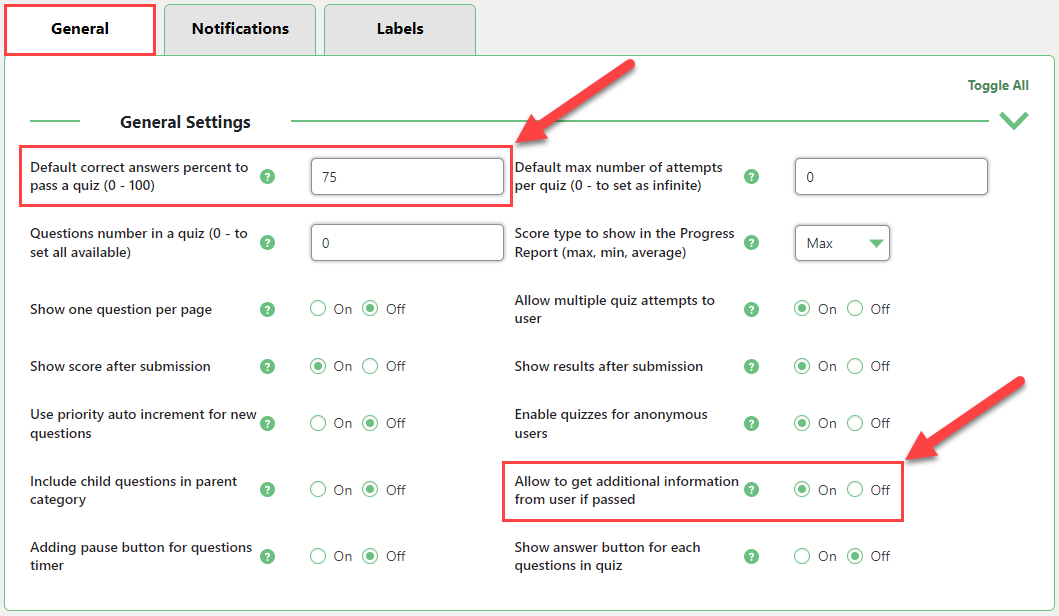
Then click the button Save Changes below the settings.

Reminder
To learn more about configuring the WordPress Quiz Plugin and about creating quizzes, check this use case guide: WordPress Quiz Plugin - Use Case - Creating Your First Quiz From Scratch
Now let's see the result on the front-end.
End Result
Following instructions found in the plugin and guides you should be able to integrate WordPress Quiz Plugin with After Registration Extended Profile Fields, and ask your users to provide additional information about them after they pass a quiz.
Use Case Front-End
The user role before passing a quiz and completing the questionnaire is Subscriber.

The user passes the quiz:

When the quiz is successfully passed, the user sees the questionnaire:

When the user fills all needed fields and clicks Update, there appears a message about success:

And his user role is changed:

 |
More information about the WordPress Quiz Plugin Other WordPress products can be found at CreativeMinds WordPress Store |
 |
Let us know how we can Improve this Product Documentation Page To open a Support Ticket visit our support center |
